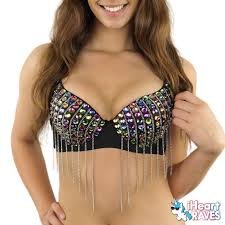
The rave tops and bras designed to support or cover the wearer's breasts. Bras are designed for a variety of purposes, including enhancing a woman's breast size, creating cleavage, or for other aesthetic, fashion, or more practical considerations. Swimsuits, camisoles, and backless dresses may have built-in breast support with supportive bra cups. Nursing bras are designed to facilitate breastfeeding. Some women have a medical and surgical need for brassieres, but most women wear them for fashion or cultural reasons. There is no evidence that bras really prevent breasts from sagging.
Bras have gained importance beyond their mere functionality as a garment. Women's choices about what kind of bra to wear are consciously and unconsciously affected by social perceptions of the ideal female body shape, which changes over time. Bras have become a fashion item and cultural statement that are sometimes purposefully revealed by the wearer or even worn as outerwear.
A bra is one of the most complicated garments to make. A typical design has between 20 and 48 parts, including the band, gore, side panel, cup, apex, neckline, underwire, strap, ring, slider, strap join, and closure. Bras are built on a square frame model.
Bras were originally made of linen, cotton broadcloth, and twill weaves and sewn using flat-felled or bias-tape seams. They are now made of a variety of materials, including Tricot, Spandex, Spanette, Latex, microfiber, satin, Jacquard, foam, mesh, and lace which are blended to achieve specific purposes. Spandex, a synthetic fiber with built-in "stretch memory", can be blended with cotton, polyester, or nylon. Mesh is a high-tech synthetic composed of ultra-fine filaments that are tightly knit for smoothness.
Bras may be designed to enhance a woman's breast size, or to create cleavage, or for other aesthetic, fashion, or more practical considerations. Nursing bras are designed to aid breastfeeding. Compression bras, such as sports bras, push against and minimize breast movement, whereas encapsulation bras have cups for support. Breast support may be built into some swimsuits, camisoles, and dresses.
Bras come in a variety of styles, including backless, balconette, convertible, shelf, full cup, full coverage bra, demi-cup, minimizing, padded, plunge, lounge bra, posture, push-up, racerback, sheer, strapless, T-shirt, underwire, unlined, and soft cup. Some special styles are manufactured by companies like plus-size bra, bridal bra, and cancer bra. Cancer bra is special in its kind for breast cancer patients whose breast removed in the operation. The styles help them to look natural after the operation.
Tops and bras designed to support or cover the wearer's breasts. Bras are designed for a variety of purposes, including enhancing a woman's breast size, creating cleavage, or for other aesthetic, fashion, or more practical considerations. Swimsuits, camisoles, and backless dresses may have built-in chest support with supportive bra cups. Nursing bras are designed to facilitate breastfeeding. Some women have a medical and surgical need for bras, but most women wear them for cultural or fashion reasons. There is no evidence that bras actually prevent sagging breasts.
Bras have gained importance beyond their mere functionality as a garment. Women's decisions about what type of bra to wear are consciously and unconsciously affected by social perceptions of the ideal female body shape, which changes over time. Bras have become a fashion item and a cultural statement that is sometimes purposely revealed by the wearer or even as outerwear.
A bra is one of the most complicated garments to make. A typical design has between 20 and 48 parts, including the band, gore, side panel, cup, apex, neckline, hoops, strap, ring, slider, strap joint, and closure. The bras are built on a square frame model.
Originally bras were made from linen, cotton fabric, and twill fabrics and sewn with flat seams or diagonal tape. They are now made from a variety of materials, including Tricot, Spandex, Spanette, Latex, Microfiber, Satin, Jacquard, Foam, Mesh, and Lace that are mixed together to achieve specific purposes. Spandex, a synthetic fiber with built-in "stretch memory", can be mixed with cotton, polyester, or nylon. Mesh is a high-tech synthetic made up of ultra-fine filaments that are tightly bonded for softness.
Bras can be designed to enhance the size of a woman's breasts or to create cleavage, or for other aesthetic, fashion, or more practical considerations. Breastfeeding bras are designed to aid breastfeeding. Compression bras, like sports bras, push and minimize breast movement, while encapsulating bras have support cups.
Bras come in a variety of styles, including backless, balconette, convertible, shelf, full cup, full coverage bra, semi cup, minimizing, padded, plunge, lounge bra, posture, push-up, racerback, sheer, Strapless, T-Shirt, Underwired, Unlined and Soft Cup. Some special styles are made by companies like the plus-size bra, the bridal bra, and the cancer bra. The cancer bra is special in its type for patients with breast cancer who were removed during the operation. Styles help them look natural after surgery.